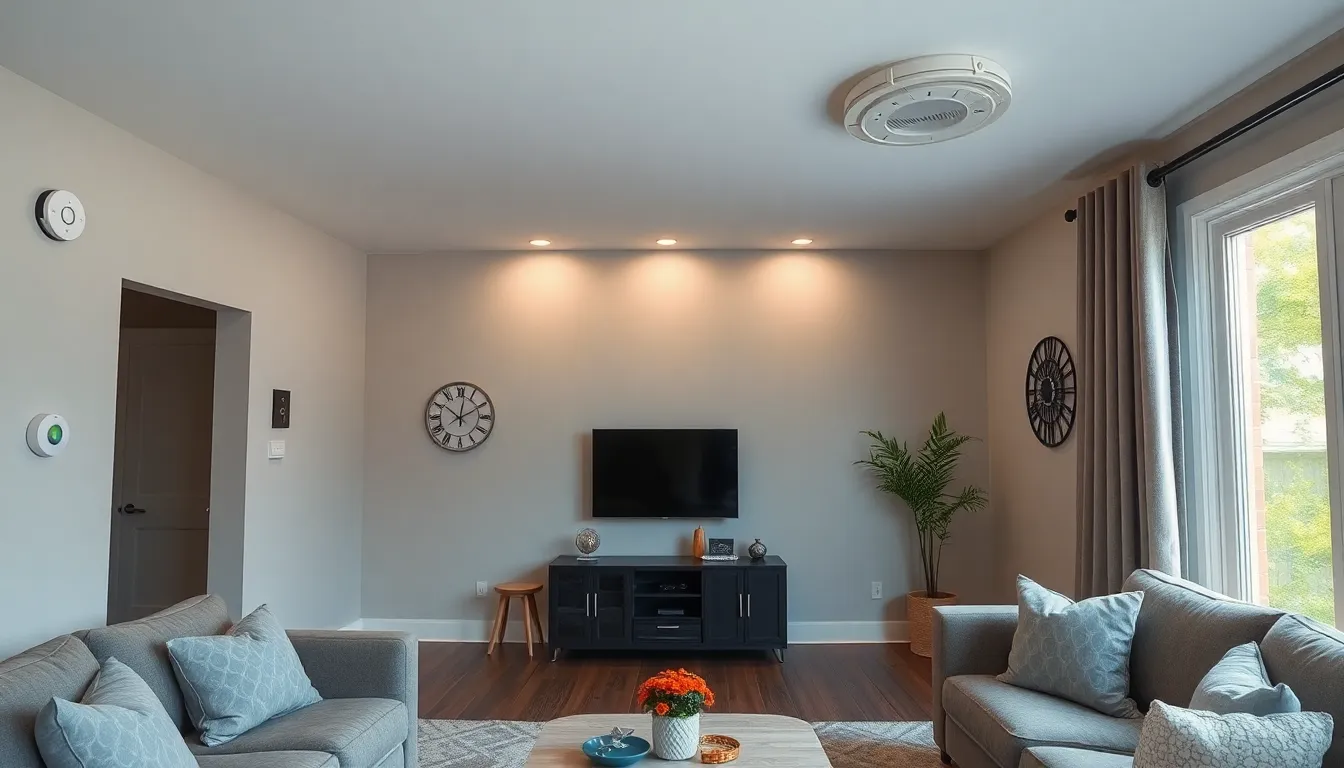Table of Contents
ToggleSmart home sensors are revolutionizing how people interact with their living spaces. These innovative devices offer real-time data and automation, making homes not just smarter but also safer and more efficient. From detecting motion to monitoring air quality, smart sensors provide homeowners with the tools to enhance comfort and security.
As technology continues to evolve, the integration of smart sensors into everyday life becomes increasingly seamless. They allow for remote monitoring and control, enabling users to manage their homes from anywhere. With the rise of the Internet of Things (IoT), smart home sensors are becoming essential components in creating a connected lifestyle. Whether it’s optimizing energy use or alerting homeowners to potential hazards, these sensors play a crucial role in modern home management.
Overview Of Smart Home Sensors
Smart home sensors play a crucial role in enhancing the functionality of connected living spaces. These devices detect changes in various environmental conditions and report data in real time. They promote comfortable, secure, and efficient home environments by interacting with other smart devices and systems.
Types of Smart Home Sensors
- Temperature Sensors: Monitor ambient temperature to optimize heating and cooling systems, enhancing energy efficiency.
- Motion Sensors: Detect movement to enhance security and automate lighting, providing convenience for homeowners.
- Smoke Detectors: Alert residents to smoke or fire, significantly improving household safety and enabling faster emergency responses.
- Water Leak Sensors: Identify moisture levels and potential leaks, preventing costly water damage and ensuring property protection.
- Door/Window Sensors: Notify homeowners of opened or closed entry points, enhancing security and enabling remote monitoring.
Benefits of Smart Home Sensors
- Real-Time Monitoring: Provide immediate data on environmental changes, allowing residents to respond swiftly to potential issues.
- Automated Control: Enable the automatic adjustment of home systems based on sensor data, leading to increased energy efficiency and comfort.
- Safety Alerts: Offer alerts for hazards such as smoke, leaks, or unauthorized entry, enhancing home security.
- Remote Access: Allow homeowners to monitor and control their home environment from anywhere, contributing to convenience and peace of mind.
Integration with Smart Home Systems
Smart home sensors integrate seamlessly with various smart devices, forming a cohesive ecosystem. This integration enables automation scripts to be triggered by specific sensor readings. For example, motion sensors can turn on lights, while temperature sensors adjust HVAC systems based on real-time data. Integration with voice assistants enhances user interaction and control options.
Conclusion of Previous Content Flow
Smart home sensors contribute significantly to modern living by optimizing comfort, safety, and energy use. Their real-time capabilities and seamless integration make them indispensable in today’s connected homes. As technology advances, the potential for enhanced functionality and user experience continues to grow, aligning with the expanding Internet of Things.
Types Of Smart Home Sensors

Smart home sensors contribute significantly to enhanced security and efficiency in residential settings. Various types of sensors serve unique purposes, ensuring homes remain safe and comfortable.
Motion Sensors
Motion sensors detect movement within specified areas, enabling enhanced security by monitoring entrances and high-traffic zones. They activate security alarms or notifications when unexpected motion occurs. Motion sensors also support automation, triggering lights or climate controls based on occupancy, thereby improving energy efficiency. Common types include passive infrared (PIR) sensors, which sense body heat, and dual-technology sensors that combine PIR with microwave detection for higher accuracy.
Temperature Sensors
Temperature sensors measure environmental temperatures, ensuring optimal climate conditions in households. They allow users to maintain desired comfort levels by connecting to smart thermostats, which can automatically adjust heating and cooling systems based on real-time data. Temperature sensors notify homeowners of extreme fluctuations, potentially preventing damage to property or loss of personal belongings. These sensors often integrate with larger home automation systems for comprehensive climate control.
Smoke and Carbon Monoxide Detectors
Smoke and carbon monoxide detectors provide essential safety features by detecting harmful gases and smoke in real-time. These sensors trigger loud alarms upon detecting smoke or elevated carbon monoxide levels, alerting occupants of potential dangers. Smart detectors connect to mobile devices, delivering alerts and updates even when homeowners are away. Additionally, some models offer self-testing capabilities and notifications for low battery levels, ensuring optimal functionality.
Benefits Of Using Smart Home Sensors
Smart home sensors deliver numerous advantages that modernize living environments. Their functionality improves security and promotes energy conservation, which contributes to a more efficient and safe home.
Enhanced Security
Enhanced security is a primary benefit of smart home sensors. Motion sensors monitor movement in and around homes, triggering alarms or sending notifications when unauthorized activity occurs. Door and window sensors provide real-time alerts if access points open unexpectedly, allowing immediate response. Integration with surveillance cameras offers visual verification, enhancing peace of mind. Smoke and carbon monoxide detectors qualify as essential safety devices, alerting homeowners to potential hazards even when they’re away. This proactive security approach significantly reduces the risk of emergencies and home invasions.
Energy Efficiency
Energy efficiency is a key advantage of smart home sensors, which optimize energy usage throughout homes. Temperature sensors monitor climate fluctuations, automatically adjusting heating and cooling systems to maintain comfort levels while minimizing energy waste. Smart lighting sensors detect occupancy, ensuring lights turn off in unoccupied rooms, ultimately reducing electricity bills. Additionally, smart thermostats utilize data from sensors to learn user preferences, automatically adjusting settings for maximum efficiency. This combination of automation and real-time monitoring leads to a notable decrease in energy consumption, translating to cost savings and a reduced environmental footprint.
Challenges In Implementing Smart Home Sensors
Implementing smart home sensors brings challenges that require careful consideration. Addressing these obstacles ensures effective integration and user satisfaction.
Privacy Concerns
Privacy concerns frequently arise with smart home sensors. These devices collect sensitive data, including personal habits and home activities. Inadequate data protection can lead to unauthorized access or misuse of information. Homeowners need to review privacy policies and ensure devices have robust security features, such as encryption and two-factor authentication. Regulatory compliance, like the General Data Protection Regulation (GDPR), may also play a role in ensuring adequate protection of individual privacy rights.
Compatibility Issues
Compatibility issues often complicate the integration of smart home sensors. Different manufacturers may use varying protocols and standards, limiting interoperability between devices. Home automation systems may struggle to communicate effectively, causing user frustration. Selecting sensors that comply with popular protocols, such as Zigbee, Z-Wave, or Wi-Fi, helps mitigate these issues. Additionally, maintaining updated firmware and software enhances compatibility and performance across connected devices.
Smart home sensors are revolutionizing the way people manage their living spaces. By providing real-time data and automated control they enhance comfort and security while promoting energy efficiency. As these technologies evolve their integration into daily life becomes increasingly seamless.
Homeowners can enjoy the peace of mind that comes from knowing their homes are equipped with advanced monitoring systems. Despite challenges like privacy concerns and compatibility issues the benefits far outweigh the drawbacks. With the right choices in smart home sensors individuals can create a more efficient and secure living environment. The future of home management is bright as these innovations continue to develop and adapt.


